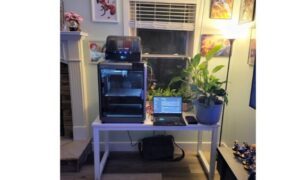Welcome to the world of 3D design, where imagination comes to life and creativity knows no bounds! In this exciting era of technology, we have witnessed a remarkable leap forward in the way artists and creators bring their visions into existence. Enter the realm of three dimensions, a space that transcends traditional constraints and empowers designers to push the boundaries of their craft. Join us on an exhilarating journey as we explore how 3D design is revolutionizing creative industries, unleashing untapped potential, and enabling us all to dream bigger than ever before. Get ready to be inspired, amazed, and captivated by the incredible possibilities that await in this new dimension!
Designing in a New Dimension: How 3D is Empowering Creativity
We live in a three-dimensional world, so it’s no surprise that the field of 3D design has exploded in popularity in recent years. Whether you’re looking to create simple 3D models for fun or complex designs for professional use, the D platform is a great place to start.
In this article, we’ll give you a brief introduction to 3D design and show you how D can help you unleash your creativity. We’ll cover the basics of 3D modeling, rendering, and animation, and explain how D’s powerful tools and features can take your designs to the next level. Ready to get started? Let’s dive in!
Benefits of Working in 3D
Working in three dimensions has a number of advantages over working in two dimensions. First, it allows for a more realistic representation of objects. Second, it gives designers more freedom to create complex shapes and designs. Third, it makes it easier to visualize how objects will look in the real world. Working in three dimensions can help designers better understand the relationships between objects.
Types of 3D Design Tools and Software
There are many different types of software and tools available for 3D design. Some of the most popular and widely used include Autodesk Maya, 3ds Max, Cinema 4D, and Blender. These programs allow users to create and edit 3D models, animations, and simulations. They can also be used for rendering and printing purposes.
Other popular 3D design tools include SketchUp, 123D Design, Tinkercad, FreeCAD, and Fusion 360. These programs are mostly used for creating simple 3D designs or for prototyping purposes. They are usually less complex than the aforementioned programs and have a shorter learning curve.
What industries are using 3D?
The use of 3D printing is growing in many different industries as the technology becomes more accessible and less expensive. Here are some examples of how 3D printing is being used in various industries:
Automotive: 3D printing is being used to create prototype parts for automobiles. This allows designers to quickly iterate on designs and test new ideas without incurring the high costs of traditional manufacturing methods.
Aerospace: 3D printing is being used to create engine components and other parts for aircraft. This allows for faster production times and reduced costs compared to traditional manufacturing methods.
Consumer goods: 3D printing is being used to create a variety of consumer goods, such as eyewear, jewelry, and home decor items. This allows companies to offer unique, customized products that can be produced on demand.
Medical: 3D printing is being used to create prosthetic limbs, implants, and other medical devices. This allows for tailored solutions that can be created quickly and efficiently.
Creating Unique Visual Effects with 3D
3D rendering is the process of creating images from three-dimensional models. This can be done with various software programs, but the most popular ones are Autodesk 3ds Max, Maya, and Cinema 4D.
There are many ways to create unique visual effects with 3D rendering. One popular method is to use particle systems. Particle systems are simulations of small objects that follow certain rules or behaviors. They can be used to create things like fire, smoke, water, and explosions.
Another way to create unique visual effects is by using shaders. Shaders are special effects that can be added to 3D models to change the way they look. For example, you could use a shader to make a model look like it’s made of glass or metal.
If you’re looking for even more creative control, you can try using sculpting tools. Sculpting tools allow you to shape and mold models in any way you want. This gives you a lot of freedom to create whatever kind of effect you’re looking for.
No matter what kind of visual effect you’re trying to create, there’s a good chance you can do it with 3D rendering. With the right software and some creativity, the sky’s the limit!
Practical Uses for 3D Design
When it comes to 3D design, the possibilities are endless. With the help of 3D printing technology, designers are now able to create 3D objects that were once impossible to make. This has opened up a whole new world of possibilities for both artists and engineers.
Some of the most popular uses for 3D design include:
Creating prototypes: Designers can now quickly and easily create prototypes of their products using 3D printers. This allows them to test out different designs before committing to a final product.
Customization: With 3D printing, it’s easy to create customized products that are unique to each customer. This is perfect for businesses that want to offer a personalized experience.
Art: 3D printers have also allowed artists to push the boundaries of art by creating sculptures and other pieces that would be impossible to make with traditional methods.
Education: D-printed models are being used more and more in educational settings as a way to help students visualize complex concepts.
Challenges Faced When Working in 3D
3D design is a relatively new field, and as with any new technology, there are a few challenges that need to be overcome. One of the biggest challenges is getting accurate measurements. When working in two dimensions, you can use a ruler or tape measure to get exact measurements. However, when you add a third dimension, things become a bit more complicated. You need to be able to visualize the object in three dimensions in order to take accurate measurements.
Another challenge is finding the right software. There are many different 3D design programs available, and it can be difficult to find one that meets your needs. You need to consider what type of objects you want to create, how complex they need to be, and whether you need any special features like animation or rendering.
You need to think about how you’re going to print your designs. 3D printing is still a relatively new technology, and there are a limited number of ways to do it. You need to find a printer that can handle the size and complexity of your designs, and you also need to make sure that the materials you’re using are compatible with the printer.
Conclusion
All in all, 3D design has revolutionized the creative process for many designers and artists. It has enabled them to create complex shapes and models that would otherwise be impossible with traditional tools. 3D printing technology has also made it easier for creatives to prototype their ideas quickly and produce products or artwork on a smaller scale. No matter what your level of experience is, there are plenty of ways to use 3D design tools to express yourself creatively and bring your wildest ideas into reality!



































